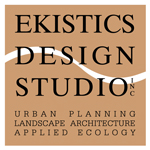Planned Communities include projects of large scale mixed use development with a predominant focus on residential development with supporting commercial, office and recreational uses. Planned Communities usually encompass wetlands and natural resources that need to be addressed creatively in the planning process. New Urbanist principals are increasing applied to create a mix of homes and services reminiscent of traditional small towns and neighborhoods.
Infill development for downtowns and urban redevelopment pose unique challenges not found in most suburban or rural sites (i.e. small parcels under multiple ownership and constraints posed by historical buildings, existing street networks and grand trees). Site development standards tailored to suburban development are inappropriate and consequently urban sites benefit from form-based performance zoning, site specific approvals and variances.
Highways, airports, rail systems and city streets connect us together. These connections must reconcile relationships to the environment and urban fabric. Impact assessment and mitigation through design enhancement are critical components of a transportation related design approach.
Commercial development includes projects that involve shopping centers, retail outlets, office parks, industrial parks, hotels and resorts. Planning and design for commercial facilities requires a knowledge of land development codes and spatial requirements of the user. Not to be overlooked is the opportunity to artistically approach site planning while at the same time meet goals of density and yield.
Subdivision platting has been for many years the specialty of civil engineers. While civil engineers are a crucial part of subdivision development, they often lack the perspective of a planner, landscape architect or ecologist. Creating an aesthetically pleasing and functional subdivision can compatible with engineering criteria while providing equivalent or improved lot yield.
Multi-family development includes Apartments, Condominiums, Townhomes and Patio Homes. Creative solutions to parking and a close attention to building to building orientation are crucial to making higher density development appear more desirable. Multi-family lifestyles require more attention to recreation amenities and common landscape development.
Special needs groups include Nursing homes, Alzheimer’s treatment facilities, Assisted Living, Children’s Homes and Recovery/Treatment facilities. Housing for special needs necessitates a custom approach to design development. Most benefit from the inclusion of privacy courts, outdoor gathering spaces or sensory and healing gardens.
A successful affordable housing project is indistinguishable from market rate housing in exterior form. Preservation of natural features and landscape amenities are some of the most economical ways to enhance the image of a project and to make it compatible with surrounding development.
Community Centers and Public Facilities
Public facilities demand the knowledge of commercial development and the needs of government agencies with a public end user perspective. These facilities are often sited in parks or other open space and may need to respond to broader use needs or pre-existing design elements.
Schools, and in particular public schools, require a minimalist approach that achieves project goals with an efficient and long lasting design scheme. School design should include educational elements into the design so that the school can act as a learning lab.
The design approach for resorts and estates are closely related and are differentiated by intensity of use and privacy. Successful examples of both rely heavily on thematic approaches to design and are the result of programs tailored to the intended user.
Aquariums/Zoos, Museums, Exhibits
High profile public projects such as Aquariums, Zoos, Museums, and Nature Centers rely on a thematic approach to design. The goal is to engage the visitor to see the vision and to feel the intent of the project. A successful design approach is like a series of storyboards taking the visitor through a journey of experience, entertainment and education.
Park uses include playfields, playgrounds, gardens, community centers and linear parks or greenways. Trends in park planning include an increasing application of trails and greenways as park space that provides both non-vehicular transportation and recreation. Due to the small percentage of built features included in parks, it is crucial that a family of design theme elements be assembled to coordinate, park benches and furnishings, shelters, bridges as well as identification education and wayfinding signage.
Cemeteries and Memorial Gardens
Traditional concepts of human burial and cemeteries have been challenged by changing perceptions. Large impersonal cemeteries have lost their appeal and the concept of cremation is maturing with an increasing use of columbaria for cremated remains. Cemeteries and columbaria have design standards and details particular to this land use. Memorial gardens are transforming these features into multipurpose outdoor space for prayer and meditation.
Churches differ from commercial development in that they are usually both and owner/developer and a community of faith. Churches require a reverent approach that respects and includes elements of faith into the design of facilities. Phased development, consensus building and funding limitations must be understood to be successful.
As agriculture becomes increasingly dominated by industrialized farming, traditional farms and ranches are being marginalized. Rural lands need to be repurposed to have relevance as agricultural uses and that may include rural estates and hobby farms. The rise of community gardens and urban agriculture are a result of the public’s desire for healthy local alternatives for food. Urban agriculture can conflict with zoning regulations and requires an advocate with an understanding of available strategies.
Preserves, Mitigation Banks, Greenbelts
Open space plans are never stand-alone projects. Whether part of an overall development plan or as part of public space, these projects require a thoughtful response to existing conditions and program goals.
Innovative Stormwater Applications
Stormwater is an integral part of urban hydrology and hence part of the urban ecology. New approaches to solving stormwater issues do not necessarily need to sacrifice additional land or result in unacceptable costs. Landscape areas provide numerous opportunities for dual functions.
